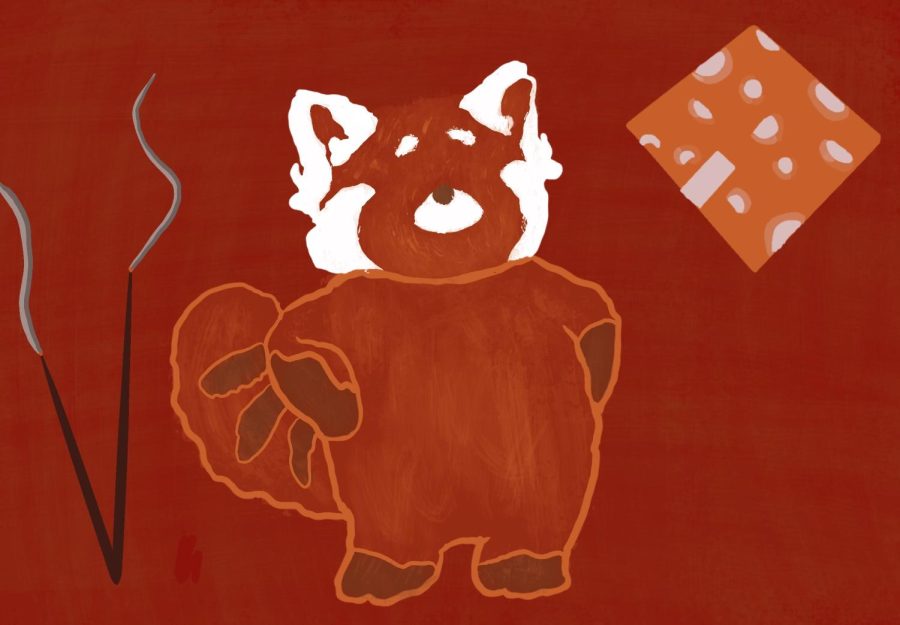Turning Red: The Movie Teenage Girls Need Right Now
April 2, 2022
The release of Pixar’s newest movie Turning Red has brought some mixed emotions from audiences. Its messages were especially relevant in the Asian American community due to the nuanced ideas on intergenerational trauma and cultural divides between different generations.
Turning Red is a powerful debut as it is director Domee Shi’s first full-length film, and breaks barriers by mentioning menstruation, puberty, and parental relations in a children’s movie.
The first female solo director of a Pixar feature film, Shi wanted to make a film that featured her experiences growing up that others could relate to and create an unabashed view of teenage girls and growing into womanhood.
The film follows 13-year old, Canadian-Chinese Meilin “Mei” Lee, and her transition into adolescence, with the small added factor of turning into a red panda due to an ancient spell. The spell affects all female members of the family and arises when Mei faces extreme emotion.
This slightly outrageous plot is actually ingenious as it creates the perfect metaphor to encapsulate the multi-complicated struggles she faces at this point in her life.
To look at why Mei’s supernatural powers are so important to her real-life struggles, we need to break down everything Shi adds to make the story so cohesive and impactful.
Including references to almost all aspects of the life of a teenage girl during the early 2000s, from boy-band crazes, friend group struggles, and vibrant style of clothing, Shi creates a true aesthetic that fits the feel of pre-teens in the time period.
Below the details of 2000s teen life, Shi also adds details that relate specifically to her Asian-American audiences, as Mei’s family runs a traditional temple and she holds close to her culture and family values in her day-to-day life.
“It’s so nice to see these elements (of Asian culture) just casually being there. Having all these elements throughout the movie…it just showed that the director cared” said Asian-American vlogger Frederic Chen in a movie review on the film.
Even past both the generational and cultural relatability, Shi also touches on menstruation when Mei’s mother did not know Mei got her panda and assumed she started her first period. Her immediate rush to get “supplies” and attempts to help her daughter was a scene that any young girl could relate to upon viewing.
With so many factors incorporated into the story, Shi does an incredible job of piecing together all these issues through her storytelling of Mei’s transformation struggles.
During her first transformation, Mei’s overprotective mother thinks she has gotten her first period and goes so far as to bring pads during Mei’s class, showing how scary and stressful such a change can be.
Her panda is also a symbol of her family history and the intergenerational trauma that comes with one’s cultural history and how she deals with this issue which has affected her family for centuries.
While Mei sees this power as a gift and enjoys her abilities, her mother and other family members urge her to get rid of it as they did. The panda over time has become a burden they all must carry and is now placed with Mei, who has to deal with this change in addition to her personal transition into a different stage of life.
The idea of a disconnect between different generations in the way they perceive and handle their culture, even to the point where it creates rifts between family members, is an issue so many POC audience members could personally relate to and is an incredibly nuanced idea to show to a younger audience.
However, not all view these messages as being so relatable, the main complaint of the film being that it was too rooted in Shi’s own experience for anyone else to fully connect to.
“It does come from a clear place of passion…but I just didn’t get a whole lot out of it,” says movie review channel Schaffrillas Productions.
These issues come from a place of a valid complaint, but the movie’s reach overshadows the disconnect with a few audience members.
Asian American communities, especially female Asian Americans, have only recently experienced some sort of true representation in media in recent years, so such a poignant passion project from another authentic perspective is an incredibly special and unique thing, especially in a children’s movie and from a company as large as Pixar.
Overall, Turning Red is a delightfully charming movie that manages to handle such pressing topics in a light that truly can make many young audiences feel seen.
Its adorable animation style, comedic takes on awkward pre-teen emotions, and just truly hard-hitting moments of the trauma which is passed between generations make this film unique and delightful, definitely worth a watch.




